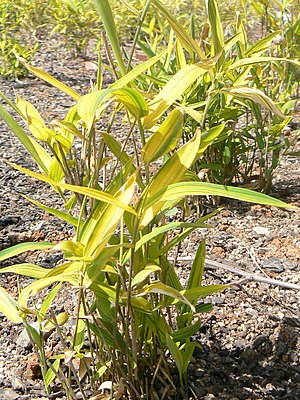Pleioblastus viridistriatus
| Pleioblastus viridistriatus | ||||||||||||
|---|---|---|---|---|---|---|---|---|---|---|---|---|

Pleioblastus viridistriata in Parc de Vallparadís, Terrassa , Spain |
||||||||||||
| Systematics | ||||||||||||
|
||||||||||||
| Scientific name | ||||||||||||
| Pleioblastus viridistriatus | ||||||||||||
| ( Rule ) Makino |
Pleioblastus viridistriatus ( synonym : Arundinaria viridistriata ) is a low, woody bamboo - type that thrives in temperate climates. The country of origin is Japan, but it is also used as an ornamental plant in Central Europe.
description
Pleioblastus viridistriatus is perennial and forms leptomorphic rhizomes . The woody stalks grow upright, are 20 to 60 centimeters long and 1 to 2 millimeters in diameter. The internodes are round, hollow and hairy under the knot just like the stalk knot itself. No or only a few lateral branches are formed. The stem leaf sheaths are finely downy with hairs bent back. The blade blades are lanceolate, about 0.5 centimeters long and stand erect. The leaf sheaths are also finely hairy. The ligule is membranous and may be ciliate. The leaf blade is connected to the leaf sheath with a short, stem-like base. (Sweet grasses do not form petioles). The blade is lanceolate, 15 to 20 centimeters long and 15 to 25 millimeters wide, medium green to yellowish green and striped. Both spider sides are dense, hairy downy. The end of the spread is pointed. The species loses its leaves in winter.
The inflorescences consist of a few spikelets , one to three spikelets being fertile and stalked. The fertile spikelets have six to 8 florets with one not fully developed florets on top. The spikelets are linearly shaped, laterally flattened and 40 to 50 millimeters long. A permanent glume is formed. It is shorter than the spikelet, lanceolate, 10 to 23 millimeters long, membranous, not keeled, seven times veined and pointed. There may be another one below, but it is inconspicuous. Depending fertile floret is an elliptical, 13 to 15 millimeters long, formed sevenfold veined, membranous, tapered lemma without keel. The palea is about the same length as the lemma. The sterile florets growing at the tip resemble the fertile ones, but are not fully developed. Three cavernous bodies , three stamens and three stigmas are formed per flower . The fruits are caryopses with adherent pericarp and a tip without appendages.
distribution
The species is native to Japan and is also cultivated in the United States and New Zealand.
Systematics
Pleioblastus viridistriatus is a bamboo - type from the genus Pleioblastus that the tribe Arundinarieae is attributed to the woody bamboo species of the temperate climate zones. It was first described in 1866 by Eduard August von Regel as Bambusa viridistriata ( Basionym ) and placed in the genus Pleioblastus by Makino Tomitarō in 1926 . It is often assigned to the genus Arundinaria under the synonym Arundinaria viridistriata .
Further synonyms of the species are: Arundinaria auricoma Mitford , Arundinaria fortunei var. Aurea (Carrière) Bean , Arundinaria variabilis var. Viridistriata (rule) Matsum. , Arundinaria variegata var. Viridistriata (rule) Makino , Arundinaria viridistriata f. chrysophylla (Makino) Nemoto , Bambusa fortunei var. aurea Carrière , Pleioblastus auricomus (Mitford) DCMcClint. , Pleioblastus viridistriatus f. chrysophyllus Makino , Pseudosasa auricoma (Mitford) Bergmans , Sasa auricoma (Mitford) EGCamus , Sasa viridistriata (Rule) Fiori and Sasaella viridistriata (Rule) Nakai .
use
In Central Europe, Pleioblastus viridistriatus is used in beds, as border plantings or as a container plant. Its luminous foliage, which falls off in winter and is damaged in blazing sun, is striking. The species tolerates frost down to about −22 ° Celsius.
Individual evidence
- ↑ a b c d W. D. Clayton, M. Vorontsova, KT Harman, H. Williamson: Arundinaria viridistriata. In: GrassBase - The Online World Grass Flora. Royal Botanic Gardens, accessed February 26, 2015 .
- ↑ a b c Pleioblastus viridistriatus in the Germplasm Resources Information Network (GRIN), USDA , ARS , National Genetic Resources Program. National Germplasm Resources Laboratory, Beltsville, Maryland.
- ↑ Bambusa viridistriata in the Germplasm Resources Information Network (GRIN), USDA , ARS , National Genetic Resources Program. National Germplasm Resources Laboratory, Beltsville, Maryland.
- ↑ Rafaël Govaerts (Ed.): Pleioblastus viridistriatus. In: World Checklist of Selected Plant Families (WCSP) - The Board of Trustees of the Royal Botanic Gardens, Kew . Retrieved February 26, 2015.
- ↑ Pleioblastus viridistriata. In: The Plant List. Retrieved February 26, 2015 .
- ↑ Crouzet, Colin: Bambus , p. 79.
literature
- Andreas Roloff , Andreas Bärtels: Flora of the woods. Purpose, properties and use. With a winter key from Bernd Schulz. 3rd, corrected edition. Eugen Ulmer, Stuttgart (Hohenheim) 2008, ISBN 978-3-8001-5614-6 , p. 698.
- Simon Crouzet, Oliver Colin: Bamboo . Österreichischer Agrarverlag, 2003, ISBN 3-7040-1952-6 , p. 78, 79 .
Web links
- Pleioblastus viridistriatus at Tropicos.org. Missouri Botanical Garden, St. Louis, accessed February 26, 2015.
- Fred Vaupel: Pleioblastus viridistriatus . In: The Bamboo Lexicon. Retrieved February 26, 2015 .